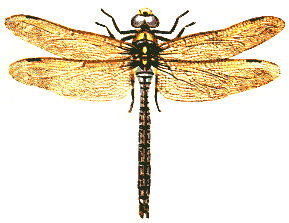 Synonyms:
Anax imperator Leach, 1815. Edinb. Enc., Vol. IX,
Edinburg, p.137; Aeshna formos: Van der Linden, 1820, p.3,
fig.1; Anax imperator Schmidt, 1929, p.40, fig.27e, 33k
Synonyms:
Anax imperator Leach, 1815. Edinb. Enc., Vol. IX,
Edinburg, p.137; Aeshna formos: Van der Linden, 1820, p.3,
fig.1; Anax imperator Schmidt, 1929, p.40, fig.27e, 33kAnax imperator Leach, 1815
 Synonyms:
Anax imperator Leach, 1815. Edinb. Enc., Vol. IX,
Edinburg, p.137; Aeshna formos: Van der Linden, 1820, p.3,
fig.1; Anax imperator Schmidt, 1929, p.40, fig.27e, 33k
Synonyms:
Anax imperator Leach, 1815. Edinb. Enc., Vol. IX,
Edinburg, p.137; Aeshna formos: Van der Linden, 1820, p.3,
fig.1; Anax imperator Schmidt, 1929, p.40, fig.27e, 33k
Common names: Engl: Emperor dragonfly; Bulg: Vodno konche-imperator; Russ: Dozorshchik; Turk: Usufcuk; Ukr: Dozorets'
Order: ODONATA
Family: AESHNIDAE
Taxonomic description: Very large insects; total body length 72-77 mm, length of hindwing 47-51 mm. Eyes very big, contiguous dorsomedially, covering most of the head. Wing pairs differently shaped, hindwing broader than foreone, especially in its dilated basal portion. Well pronounced colour dimorphism between the sexes. Male: Head, including eyes, green; wings, except for the narrow, yellow-brownish pterostigmae, colourless, veins yellow or black. Abdomen bright blue, ornamented in black. Female: Head and eyes green; wings slightly yellowish. Abdomen green to blue-greenish, dorsally ornamented in brown-black.
 IUCN
Status:
IUCN
Status:
World level: NE
Black Sea regional level: DD
Subregion level: VU
Distribution: Widely spread dragonfly species, occurring both in the Afrotropical and the W-Palearctic regions, i.e. latitudinally from Cape Province to Scandinavia, and to Central Asia in the East. Established all over the Balkan peninsula except Albania.
Habitats type, Critical habitats, Limiting factors: Ecologically broadscoped insect, inhabiting slow-running and rich in vegetation localities of the rhithral, and, most of all lakes, marshes and flooded estuary zones of rivers (limnal). Those habitats in the Black Sea coastal region, situated in, or neighbouring, urbanized or otherwise polluted sites should be considered critical. Important limiting factors are also the drying-up coastal marshes, the industrial and anthropogenic water pollution, as well as the draining and realignment of upper streams of the rivers.
Biology: Larvae phytophilous, living in stagnant or slow current basins, rich in water high vegetation. Adults occur from V to X. Active predators in all stages. Life cycle two years. Excellent fliers, they can sometimes be observed sometimes far away from the water basins.
Population trends: Although widespread, the species never occurs in mass, thus appearing rare rather than common. A decline in its density during recent decades has been observed in Black Sea coastal regions adjacent to sites with intensive development of tourist and resort urbanization.
Threats: Worsening quality of stagnant basins due to industrial and household water pollution, the resulting degradation of phyto- and zoocoenoses of the environment; being one of most beautiful and large insect species, there is also a potential thread of overcollecting.
Conservation measures taken: None.
Conservation measures proposed: Inclusion of Anax imperator in the List of vulnerable animal species, at least in the Black Sea region.
References:
Compiled by: K.Kumanski